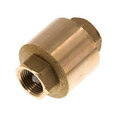Main Types of Check Valves
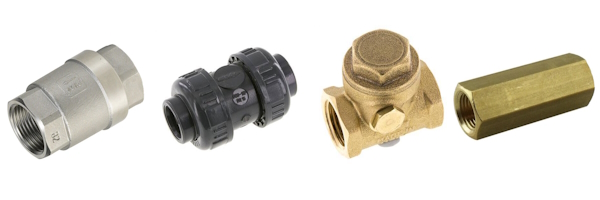
Figure 1: The variety of types of check valves makes it easy to find the right one.
Check valves allow fluid flow in one direction while preventing backflow. There are many check valve types, ensuring availability for any type of application. Choose the right kind of check valve to optimize a system's performance. This article provides an overview of different types of check valves, their designs, and key features.
Table of contents
- Inline spring-loaded check valves
- Swing check valves
- Ball check valves
- Lift check valves
- Y-shape check valves
- Foot valves
- Sanitary check valves
- FAQs
View our online selection of check valves!
Check valve comparison table
Learn more about check valves in general in our check valves working principle article.
Table 1: Comparison of Different Check Valves
| Feature/Criteria | Lift check valves | Swing check valves | Spring-loaded check valves | Ball check valves | Y-shape check valves | Sanitary check valves |
|---|---|---|---|---|---|---|
| Operation | Disc lifted by fluid flow, closes by gravity or back pressure | Hinged disc swings open with flow, closes when flow reverses | Spring mechanism compresses to open, expands to close | Ball moves away from seat to allow flow, returns to seat to block reverse flow | Y-shaped body with disc | Designed for hygienic applications, often with a spring-loaded disc |
| Advantages | Good sealing for high-pressure applications |
|
|
|
|
|
| Limitations |
|
|
|
|
|
|
| Ideal applications | Clean fluid systems with consistent flow | Water and wastewater systems with large volumes and suspended solids | Systems requiring quick response and versatile installation | Pumping systems, wastewater applications | Low-pressure steam and gas systems | Food, beverage, and pharmaceutical processing |
| Installation flexibility | Limited (horizontal only) | Limited (primarily horizontal) | High (any orientation) | Moderate (depends on design) | Moderate (depends on design) | High (often designed for easy disassembly) |
| Cost | Moderate | Low | Higher | Low to moderate | Moderate | Higher |
| Maintenance | Low to moderate, depending on debris exposure | Low | Moderate to high, due to potential spring wear | Low | Low to moderate | Moderate to high, due to hygiene requirements |
Inline spring-loaded check valves
An inline spring-loaded check valve uses a spring mechanism to assist in closing. The valve has a disc or poppet that is held in place by a spring. When fluid flows in the desired direction, the pressure overcomes the spring force, allowing the disc to move and permitting flow. When the flow stops or reverses, the spring pushes the disc back to its seat, preventing backflow.
Design
- Compact design: Inline spring-loaded check valves are typically compact and can be installed in any orientation.
- Quick response: The spring mechanism ensures a rapid response to flow direction changes, minimizing the backflow risk.
- Low cracking pressure: These valves can be designed with low cracking pressures, which is the minimum upstream pressure required to open the valve, making them suitable for systems with low-pressure differentials.
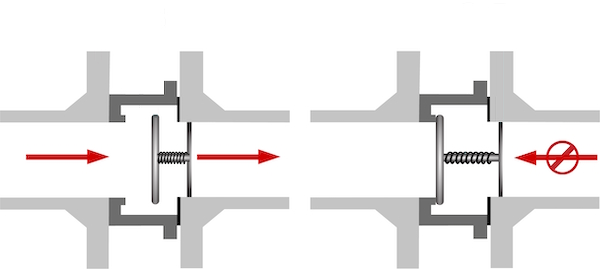
Figure 2: An inline check valve diagram: Normal flow (left) and low or reverse flow (right)
Swing check valves
A swing check valve uses a swinging disc to allow or block flow. The disc, which is hinged at the top, swings open when fluid flows in the forward direction, and swings back to a closed position when the flow stops or reverses. This design allows for minimal flow resistance when the valve is open.
Design
- Simple construction: The swing check valve has a straightforward design with few moving parts, which contributes to its durability and ease of maintenance.
- Low pressure drop: When fully open, the disc swings out of the flow path, resulting in a low pressure drop across the valve.
- Suitable for large diameter pipes: These valves are often used in larger diameter pipes due to their ability to handle high flow rates with minimal pressure loss.
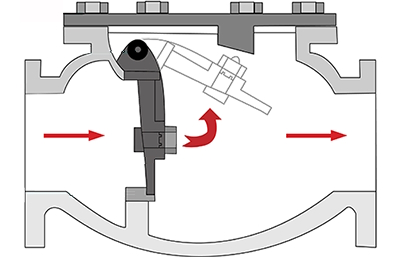
Figure 3: A swing check valve lifts open under normal flow conditions and closes under low or reverse flow conditions.
Ball check valves
A ball check valve uses a spherical ball as the closing mechanism. The ball is typically seated in a conical or spherical chamber. When fluid flows in the forward direction, the pressure lifts the ball off its seat, allowing flow. When the flow stops or reverses, gravity or back pressure forces the ball back onto its seat, effectively sealing the valve and preventing backflow. Alternatively, ball check valves may have a spring to assist with closing.
Design
- Simple and robust design: The ball check valve has a minimalistic design with few moving parts.
- Self-cleaning: The rolling action of the ball helps to clear debris from the seat, reducing the risk of clogging.
- Versatile installation: Vertical installation is preferred for optimal performance. However, these valves can be installed horizontally but will not close unless there is backpressure or a spring.

Figure 4: The ball check valve opens under normal conditions (left) and the spring helps close it under low or reverse flow conditions (right). Ball valves without a spring use gravity to close.
Lift check valves
A lift check valve is a type of check valve that uses a disc or piston that lifts vertically off its seat to allow flow. The valve body is typically similar to a globe valve, with the disc or piston moving within a guide to ensure proper alignment. When fluid flows in the forward direction, the pressure lifts the disc or piston, allowing flow. When the flow stops or reverses, gravity or back pressure causes the disc or piston to return to its seat, preventing backflow.
Design
- Vertical movement: The disc or piston moves vertically, requiring the valve to be installed horizontally for optimal performance.
- Guided disc or piston: The guided movement ensures precise seating, which enhances sealing performance and reduces wear.
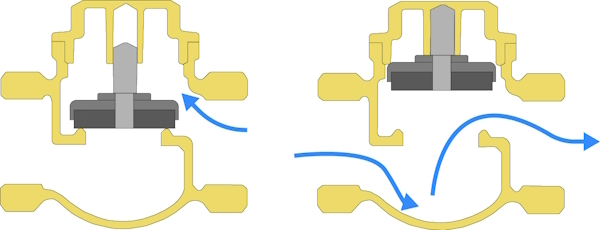
Figure 5: A lift check valve closes under low or reverse flow conditions (left), and the disc raises to allow normal flow under normal conditions (right).
Y-shape check valves
A Y-shape check valve, also known as a Y-pattern check valve, features a design where the flow path is angled, resembling the letter "Y." This configuration allows for a more streamlined flow compared to traditional inline check valves. The valve typically consists of a disc or ball that moves within the angled body to open or close the flow path.
Design
- Angled flow path: The Y-shape design reduces turbulence and pressure drop, providing a more efficient flow compared to straight-through designs.
- Reduced wear: The angled flow path can reduce wear on the valve components by minimizing the impact of fluid flow on the seating surfaces.
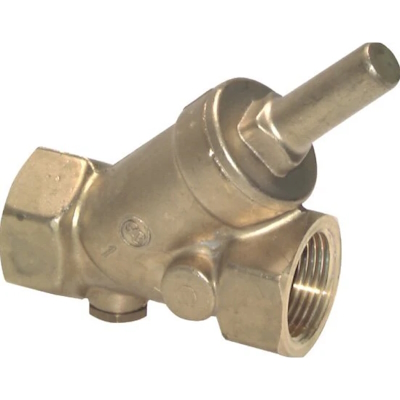
Figure 6: A y-shape check valve
Foot valves
Foot valves are a specialized type of check valve installed at the inlet of a suction line, typically at the bottom of a pump or well. They serve a dual purpose: preventing backflow and maintaining the pump's prime while incorporating a strainer to filter out debris. This combination makes foot valves essential for ensuring pumping systems' efficient and reliable operation.
Design
- Integrated strainer: Foot valves include a strainer or mesh screen to prevent debris from entering the pump and piping system, reducing the risk of clogging and damage.
- Self-priming capability: By preventing backflow, foot valves help maintain the pump's prime, minimizing the need for manual priming and enhancing pump efficiency.
- Durable construction: Typically made from materials such as brass, stainless steel, or PVC, foot valves are designed to withstand harsh environments and various fluid types.
- Variety of sizes: Available in a range of sizes to accommodate different pipe diameters and flow requirements, ensuring compatibility with various systems.
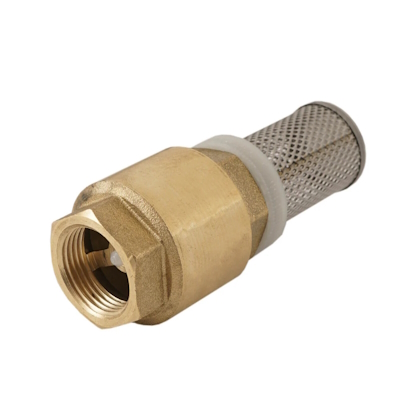
Figure 7: A foot valve
Sanitary check valves
Sanitary check valves are specifically designed for applications that require high levels of hygiene and cleanliness. These valves are used in industries where contamination must be minimized, such as food and beverage, pharmaceuticals, and biotechnology. The design of sanitary check valves ensures easy cleaning and sterilization, often featuring smooth surfaces and minimal crevices to prevent the accumulation of bacteria and other contaminants.
Design
- Hygienic design: Sanitary check valves are constructed with smooth, polished surfaces and crevice-free interiors to prevent bacterial growth and facilitate cleaning.
- Materials: Typically made from stainless steel or a special plastic such as polypropylene.
- Compliance: Designed to meet industry standards such as FDA, 3-A Sanitary Standards, and EHEDG, ensuring they are suitable for use in hygienic applications.
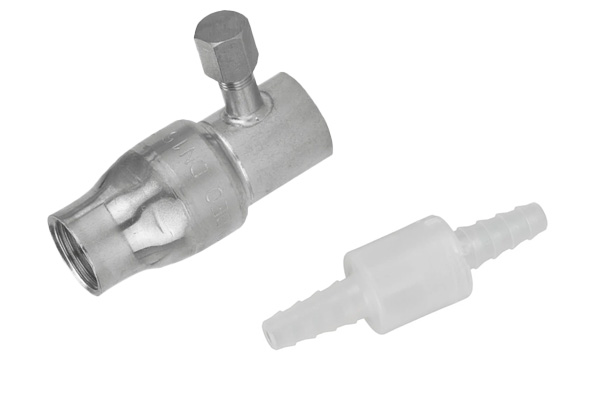
Figure 8: Sanitary check valves stainless steel (left) and polypropylene (right).
FAQs
How do swing check valves work?
Swing check valves use a hinged disc that swings open with forward flow and closes against reverse flow, preventing backflow.
What is a lift check valve?
A lift check valve uses a disc that lifts off its seat with forward flow and returns to the seat when flow reverses, stopping backflow.
Where are ball check valves used?
Ball check valves are used in low-pressure applications like wastewater systems, where a ball moves to block reverse flow.




